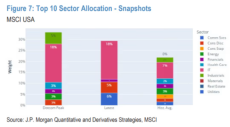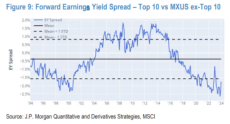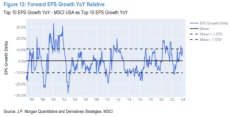
A team of quantitative strategists at J.P. Morgan see shades of the dotcom bubble in the stock-market rally that has carried the S&P 500 to six record closing highs since the beginning of 2024.
According to the team of analysts led by Khuram Chaudhry, the persistently rising concentration in the U.S. stock market has become an important risk that investors should be aware of in 2024. Although there are several important differences between the dotcom-bubble era and today, Chaudhry and his team insist that the two periods are more similar than one might initially expect.
“When viewed in a historical context, parallels to the ‘Dotcom Bubble’ era are often dismissed due to the ‘irrational exuberance’ that characterized this period. In this note, we demonstrate that there are a plethora of similarities between these two periods,” Chaudhry and his team wrote in a note viewed by MarketWatch on Tuesday.
The analysis comes at a time when the lopsided nature of stock-market returns over the past year has heavily favored shares of the largest U.S.-traded companies, a group that has earned the nickname “the Magnificent Seven.”
These stocks drove the bulk of the S&P 500’s 24.2% gain last year, according to FactSet, and have continued to outperform since the beginning of 2024. As a result, the concentration in the U.S. market is nearing its highest level since 2000.
To wit, the top-five stocks now account for 21.7% of the MSCI USA Index XX:984000 as of the end of 2023, according to J.P. Morgan’s numbers, while the share of the top 10, which includes all of the Magnificent Seven, has risen to 29.3%. For the top five, this level is within 0.7 percentage points of the post-1994 peak of 22.4% from March 2000.
The current top 10 are moderately further below their historical peak share of 33.2%, which occurred in June 2000. Still, by both measures, concentration is the highest it has been since the dotcom days.

The MSCI USA Index has 609 constituent stocks and is intended to measure the performance of large and midcap U.S.-traded stocks, according to an MSCI fact sheet on the index.
In its analysis, the J.P. Morgan team focused on several factors. For example, they determined that the number of sectors represented among the top 10 most valuable companies is actually less diverse in 2024 than it was during the peak of the dotcom bubble.
Back then, there were six sectors represented among the top 10 stocks, compared with just four today. What’s more, they found that during both periods, information-technology companies represented the biggest share of the group’s total market capitalization.

Valuations, meanwhile, mark another important difference between the dotcom era and the present day. During the dotcom era, the J.P. Morgan strategists found that forward price-to-earnings for the top 10 largest companies in the U.S. market peaked at 41.2x expected earnings. Currently, the top 10 are valued at 26.8x.

But the J.P. Morgan team highlighted an important caveat. They took the reciprocal of forward price-to-earnings, a metric known as the forward earnings yield, and measured the spread between the top 10 stocks in the MSCI USA Index and the rest of the index.
What they found is that as recently as October, the top 10 stocks in the index commanded the highest premium to earnings relative to the rest of the index on record — although since then, the premium has shrank considerably.

Meanwhile, the J.P. Morgan strategists found that the share of overall EPS growth contributed by the 10 largest stocks was actually larger during the dotcom days — helping to rebut the conventional wisdom around the period as one where stocks had become completely disconnected from fundamentals.
“While we would be hesitant to refer to the current levels of the Top 10 as a bubble, it would certainly appear that the Top 10 in the Dotcom era was backed by superior earnings developments,” the J.P. Morgan team said.

Finally, the strategists measured the difference in price returns between the top 10 stocks and the rest of the U.S. index. They found that, generally speaking, periods of strong outperformance are typically followed by bouts of mean reversion.

This would suggest that Big Tech is overdue for a period where it lags behind the broader market, like it did in 2022. Cautious about the chances of a Big Tech-led selloff, the J.P. Morgan team warned clients that they “do expect equity market drawdowns to materialize, which may well be driven by weakness in the Top 10.”
Most of the Magnificent Seven stocks were trading lower on Tuesday — with Nvidia Corp. NVDA, +0.49% and Tesla Inc. TSLA, +0.35% shares flat, Microsoft Corp. MSFT, -0.28% and Alphabet Inc. GOOGL, -1.34% shares off by less than 1%, and Apple Inc. AAPL, -1.92% and Amazon.com Inc. AMZN, -1.40% shares moving sharply lower. Meta Platforms Inc. META, -0.24% shares were the only member of the group trading higher on the day.
Weakness among the Big Tech names contributed to a 0.7% drop in the Nasdaq Composite COMP to 15,525. Meanwhile, the S&P 500 SPX was off by 0.1% at 4,924, still within striking distance of its most recent record closing high.





























